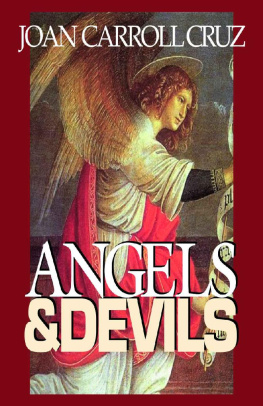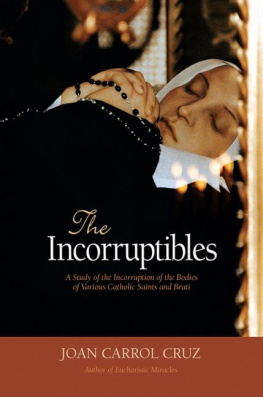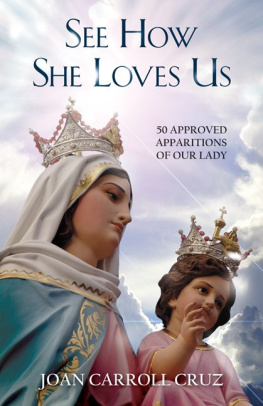
ST. CATHERINE DE RICCI (15221589) was a Dominican prioress and mystic who had frequent visions of the crucifixion of Christ. She received all the marks of His Passion, the five wounds and the crown of thorns. Our Lord once detached Himself from the crucifix in St. Catherines cell to receive her loving embrace.

Other Books by the Author
Miraculous Images of Our Lady
Secular Saints
Prayers and Heavenly Promises
The Incorruptibles
Eucharistic Miracles
Relics
The Desires of Thy Heart
| Nihil Obstat: | Rev. Stanley P. W. Klores Censor Librorum |
| Imprimatur: |  | Most Rev. Francis B. Schulte Archbishop of New Orleans July 14, 1993 |
The Nihil Obstat and Imprimatur are the Churchs declarations that a work is free from error in matters of faith and morals. It in no way implies that the Church endorses the contents of the work.
Copyright 1995 by Joan Carroll Cruz.
All rights reserved. No part of this book may be reproduced or transmitted in any form or by any means, electronic or mechanical, including photocopying, recording, or by any information storage or retrieval system, without permission in writing from the Publisher. Brief selections may be quoted or copied for non-profit use without permission, provided that full credit is given.
Cover Picture: The San Damiano Crucifix, which spoke to St. Francis of Assisi.
Library of Congress Catalog Card No.: 93-61509
ISBN: 978-0-89555-496-3
Printed and bound in the United States of America.
TAN Books
An Imprint of Saint Benedict Press, LLC
Charlotte, North Carolina
2012
God does not work miracles and grant favors by means of some statues in order that these statues may be held in higher esteem than others, but that through His wonderful works He may awaken the dormant devotion and affection of the faithful .
St. John of the Cross
Book III, Chapter 36, #1
Ascent of Mount Carmel
C ONTENTS
















A UTHORS N OTE
While researching the companion to this volume, Miraculous Images of Our Lady , it was a somewhat easy matter to find 100 images that were regarded as miraculous. There are many, many more images that could have been included in that volume, but it seemed best, in order not to have an overly large book, to stop at the round figure of 100.
For this volume, Miraculous Images of Our Lord , the gathering of miraculous images was not so easy. Despite diligent research, the present 42 images of our Saviour were all that this author could find. In the matter of miraculous images, it would seem that Our Lord graciously concedes the greater portion of the privilege to our Holy Mother.
It was known to a number of Saints that many images of Our Blessed Mother and Our Lord were regarded as miraculous, and many were the Saints who visited and prayed before these images. Some Saints have even acknowledged the miraculous nature of these images in their writings.
St. Louis De Montfort writes, There is not a church without an altar in her [the Blessed Virgin Marys] honor, not a country nor a canton where there are not some miraculous images where all sorts of evils are cured and all sorts of good gifts obtained.
St. Augustine, in writing about miraculous shrines, tells us that it is seen and known by all men that God does set a difference between one place and another, though none can penetrate His counsel and explain why it is that miracles are wrought in one place and not in another.
St. Alphonsus Liguori writes, The divine Mother has shown by prodigies how pleasing to her are the visits paid to her images. But if we are unable to visit her miraculous images which are far from home, we should visit her shrines which are readily available.
The Saint who has perhaps written the most regarding miraculous images is St. John of the Cross, who devoted Chapters 3537 of Book III to this subject in his Ascent of Mount Carmel. The Saint first tells us, The Church established the use of statues for two principal reasons: the reverence given to the Saints, Our Lord and Our Lady through them; and the motivation of the will and the awakening of devotion to the Saints by their means. Insofar as they serve this purpose their use is profitable and necessary. Again the Saint notes, Experience even teaches that if God grants some favors and works miracles, He does so through some statues that are not very well carved or carefully painted, or that are poor representations, so that the faithful will not attribute any of these wonders to the statue or painting.
The miracles are attributed, of course, to the Heavenly Father, who works His wonders through the intercession of the heavenly person the image represents.
St. John of the Cross also writes, I would like to mention some supernatural effects that certain images occasionally cause in particular individuals. God gives to some images a special spiritual influence upon souls so that their figure and the devotion they cause remain fixed in the mind as though they were present.
Images were not always favorably regarded. Early in the eighth century, a heresy known as iconoclasm initiated an image-breaking campaign based on the theory that images, pictures and relics were idolatrous. The true Catholic attitude toward the veneration of images was clearly defined at the end of the period of iconoclasm by the Second Council of Nicaea in the year 787:
Next page























